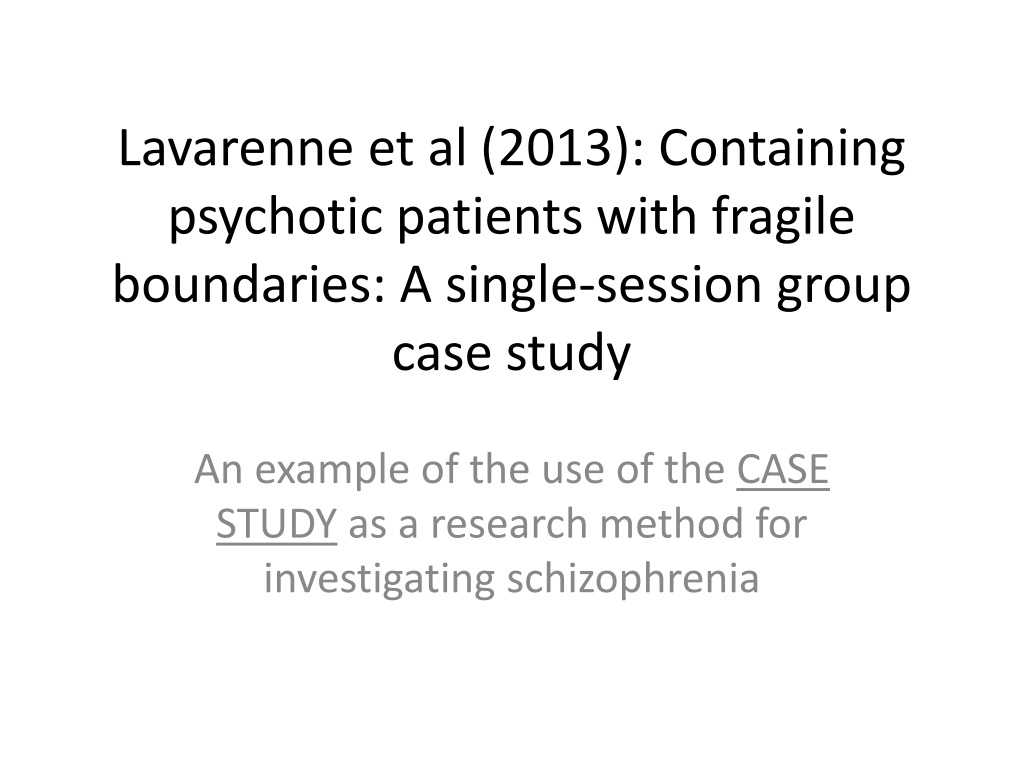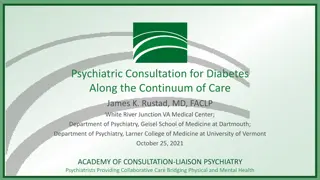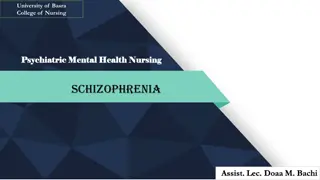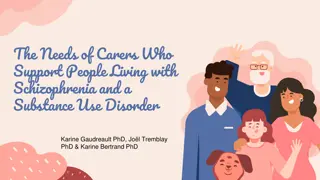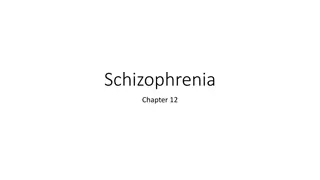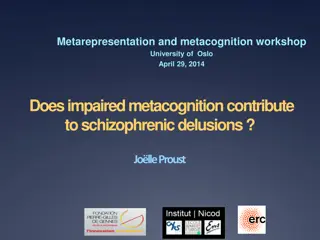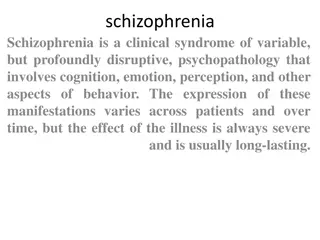Investigating Schizophrenia Through Group Therapy: A Case Study
This case study explores how group therapy sessions can provide firm boundaries to individuals with weak ego boundaries, aiming to moderate psychotic angst. The research delves into the therapeutic actions of a long-running group in dealing with psychosis and psychological crises. Through coding of sessions and scrutiny of data, the study highlights the importance of time, support, and acceptance in enhancing participants' maturation and functioning within the group setting.
Download Presentation

Please find below an Image/Link to download the presentation.
The content on the website is provided AS IS for your information and personal use only. It may not be sold, licensed, or shared on other websites without obtaining consent from the author. Download presentation by click this link. If you encounter any issues during the download, it is possible that the publisher has removed the file from their server.
E N D
Presentation Transcript
Lavarenne et al (2013): Containing psychotic patients with fragile boundaries: A single-session group case study An example of the use of the CASE STUDY as a research method for investigating schizophrenia
Aims previous research suggests that psychosis results from weak ego boundaries this study study attempts to investigate how out- patients use group sessions to provide firm boundaries which support them during their illness. examples of weak ego boundaries include a person fearing that they will break apart be annihilated wishing to be a part of someone else.
Aims contd Individuals may retreat into a fantasy world as they are unable to cope with reality. Firm boundaries are believed to moderate psychotic angst the study therefore aims to explore some of the group's core therapeutic actions against psychosis.
Background group had been running since 1985 pre-doctoral psychology interns have trained as group therapists every year since 1997 Group members have attended for various time scales the leaders role is to bear the illness with the individual during the session to minimise isolation, and allow the individuals to choose their own level of intimacy and closeness during the session separation, isolation, and intimacy are associated with psychological crises.
Coding of the sessions sessions are not tape-recorded or video-taped but are coded (since 1998) where the therapists record: Whether members express psychotic, manic, or depressed thoughts and behaviours The emotions observed (e.g. joy, anger, anxiety, sadness, guilt) Verbal expressions of loneliness, loss, dreams, current or past relationships, humour, illness, activity in their lives, helplessness, hopefulness, hopelessness, sexual preoccupation If members make supportive or insightful comments If members engaged or participated in the group
Scrutiny of previously coded data (over a seven-year period) suggested that when enough time, support and acceptance is offered, participants in the group increase their maturation and functioning in a group setting.
Procedure a single session of out-patient group therapy six individuals with schizophrenia or schizoaffective illness sessions usually had 10 members but only six attended the 45 minute session which was led by the three researchers They were called the Thursday Group as this was the day of the week when they regularly met.
Findings the six members of the group all had fragile ego boundaries, expressed in various different ways
Brett, Schizophrenic, Irish-Catholic, Caucasian Description: Gave out a Christmas card and calendar. Interpretation: Wants the group to be linked together and connected to reinforce the group boundary, to help solidify his Ego boundary. Description: Divides humanity into black, white, yellow (referring to skin colours) and speaks of threes Interpretation: To give structure and boundaries to his fragmented inner world during psychotic decompensation.
Brett contd Description: Told the group he received a gift of CDs from his sister and would keep it wrapped on the shelf to look at. Interpretation: Possibly a way of holding himself together for a time over the Christmas holiday.
Earl, Schizophrenic, African American, Born in Texas, lived in Africa with his adoptive American parents before moving to Canada. Description: Rejected gifts from Brett. Interpretation: Earl has an underlying fear of being annihilated and accepting the gift may have triggered fragmentation fears. Description: Showed grandiose, delusional ideas about a large-scale multinational engineering project. Interpretation: The delusion is holding the fragmented pieces of Earl s self together, so symbolises a boundary between Earl s self and the selves of others.
Earl contd Description: Claimed to be a Falasha (Ethiopian Jew) after being treated in a Jewish hospital. Interpretation: He has a porous Ego boundary as he absorbed a false identity.
Deena Description: Reported having nightmares for which her psychiatrist suggested she be tested for sleep apnea. She refused and said she preferred her sleep issues to be treated in a psychological way through thinking good thoughts before bedtime. Interpretation: Her focus between being awake and asleep is blurred and she therefore has a fragile Ego boundary.
Dan Description: The previous evening had an out- of-body experience and was very scared he would not be able to get his spirit back into his body . Intepretation: He felt his Ego boundary to be very fragile during this frightening experience.
Dan contd Description: Showed the group burns on his arms he had got from being distracted while cooking. He was currently trying to cope with a change in nature of his relationship with his girlfriend (a former fianc e). Interpretation: He felt his Ego boundary to be extremely fragile and was asking for the boundaries of his relationship to be clearly defined.
Dillon Description: agreed with a former member from a previous session about people staying in his house (an Aunt had moved in with the previous member) over Christmas he would struggle to cope with relatives staying he would cope by going for a walk or shovelling snow. Intepretation: His ability to be aware of how much closeness he could tolerate shows insight. The limited tolerance to personal space and closeness indicates a fragile Ego boundary.
Andy a sexually repressed and very competent mother of a daughter Description: Was offended by sexual references a former member had stated during a previous session. It is noted that she copes by swimming rigorously each day and limits her food intake Helps several young relatives with homework each day after school. Interpretation: self-sacrificing and restrictive behaviours enable her to deal with her fragile Ego boundaries.
Conclusions each group member struggles daily with the environmental, social, and biological factors in their schizophrenia sessions enable development of stronger Ego defences for each member through object relations, which enables a relationship between self and others to form Researchers saw their role as allies to the patients and that the group can serve as a buffer to prevent psychological crises which may lead to subsequent breakdown and rehospitalisation
Conclusions contd the group is serving as an auxiliary Ego- structuring mechanism to offer the members a stabilising force and promote psychological growth the group acts as containing object by establishing firm boundaries and by mentalizing patients' psychotic productions, the group may become a solid object representation introjected by individuals wrestling with porous ego boundaries and a poor sense of self.
